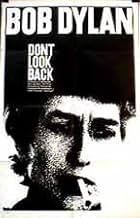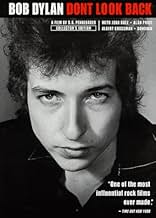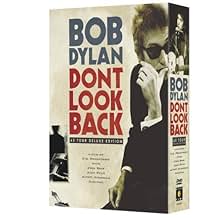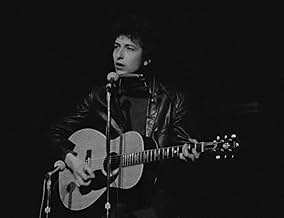Documentary covering Bob Dylan's 1965 tour of England, which includes appearances by Joan Baez and Donovan.Documentary covering Bob Dylan's 1965 tour of England, which includes appearances by Joan Baez and Donovan.Documentary covering Bob Dylan's 1965 tour of England, which includes appearances by Joan Baez and Donovan.
- Awards
- 4 wins total
- Self
- (uncredited)
- Self - science student
- (uncredited)
- Self
- (uncredited)
- Self
- (uncredited)
- Self
- (uncredited)
- Self
- (uncredited)
- Director
- Writer
- All cast & crew
- Production, box office & more at IMDbPro
Featured reviews
It's hard to know how to take Bob Dylan in this documentary. Many of the interviews shown are ones given on the fly just before he goes on stage, and a certain amount of pre-show jitters and nervous reaction is probably to be expected. I would not want to interview a musician just before they are set to perform on strange stages in a foreign country. His interviews come across as a person who has been doing way too much of what we, in fact, see Bob doing all through the film, reading his own press clippings and being very impressed with what he finds. He comes across as a person who thinks he understands all, but is too deep to be understood in turn. So deep, in fact, that mere mortal reporters are not even worth taking the time to explain things to. He wastes the reporter's and the film audience's time playing verbal games, quibbling over choics of words in questions and in general coming across as far more self-important than he really is. This can be seen as anti-establishment, it can also be seen as being a plain old pain in the butt just because you can, to entertain your buddies.
Donovan is there, and is a presence from the start of the film. Bob is very aware of him, has been told that Donovan plays better than he does. Donovan was the British version of Bob and, at times, sold better than Bob did. They finally meet and trade songs, Bob sarcastically choosing to sing "It's All Over Now, Baby Blue" right at Donovan. Joan Baez is there for a portion of the movie, beautiful and ignored by Bob and his entourage. Albert Grossman comes across as a bull in a China shop in England where the genteel older gentlemen who still handled promotion were absolutely no match for Grossman's New York tough guy ways. We see him on the phones, milking every last dollar he can from promoters.
Highly recommended documentary. For what it is worth, besides his music, this is about as close as anyone ever got to Bob Dylan. The film makers were wise in not asking any questions or directing anything, but just in letting Bob talk.
The whole movie focuses on Dylan and has a constant influx of other characters. We see the press, fans, his manager, and other business people. Throughout the movie, we never really know whom those people are, making the movie completely about Bob Dylan and his life. These other people are merely characters in his life, but he is the real important person. D.A. Pennebaker, the documentarian, is never a character either, showing that the movie is all about Dylan and not about the other people around. This allows for a deeper understanding of the singer and lets the audience see who he is for themselves, without riddling their opinion with interviews with other people.
D.A. Pennebaker has an artistic flair for music and introducing people to the deeper meaning in it. He has done other works about John Lennon, Jerry Lewis, and Jimi Hendrix. This shows that he understands the music genre and it is a place that he has delved many times. He is known for having the direct cinema style to his work. He just allows the camera to roll and it is a natural and true look at what is going on with the people he is documenting. The whole movie is an easy flow of life, combining scenes of travel and life on the road with songs of Dylan's to capture to true mood of the tour. The music is key because to truly understand Bob Dylan, you must understand the music. He writes very personal music and by using that in the documentary we are able to gain a better understanding of the man himself. Even those that go to see him understand that his music is important and something that is changing people and the way people think. So to have all the music be Dylan's allows the viewer to understand both Dylan and the impact that he had on the people during his tour. The editing of the film is consistent with the direct cinema style. There are no real cut aways or a narrator; rather there are sequences of people talking all together that then go into Dylan playing. Whenever music is being played, there is no interview or audio being used over it, it is just Dylan playing in concert or with his group of friends. Because it was edited this way we are able to hear the music and realize how important it is to the film and to the life of Bob Dylan. It is edited to seem as one constant period of time; we never see the real change as time goes on. The tour continues but it is never edited to seem as though things change from place to place. The great editing combines with the interesting cinematography that Pennebaker uses in the documentary. The film was done all in black and white and has a mix of shots that were used. The black and white is generally grainy with a balance of black and white. Pennebaker shoots the time backstage, in hotels, and in concert as if we are there. It is as if we are naturally sitting there with Dylan and all of his managers and others that tour with him. There are close up shots that show Dylan playing either on stage or behind the scenes and this gives the viewer the sense of how much he thinks and works on his songs. Most of the camera work is very controlled, though there are times where they are walking backstage, or trying to escape from a concert hall that the camera is very shaky. However, the shaky camera work allows the viewer to feel as if we are part of the tour and that we are there with them. Overall, the film Don't Look Back shows a side of Bob Dylan that most are unable to see. We see the person behind the songs and are able to understand Dylan as a person. We see that he is somewhat cocky about himself and tends to want things done his own way. We see all the chaos that follows touring as a famous star and how someone like Dylan deals with that. He is outspoken and passionate about what he believes. Pennebaker is able to give us this in depth look at Dylan and let the fans become more a part of the artist. It is a great look at Dylan and frames his life and music in a way that makes it more accessible and understandable to the general public. Looking back now, over 40 years later, we can see how Dylan started and translate that into his fame that continues today. We can see why he is one of the best artists of our time.
Shot in black and white, the film shows Dylan to be very mercurial. He is at times charming, communicative and seemingly open about his feelings. Other times--in fact most of the time--he is confrontational, condescending and self-contradictory. He is about 24 years old and these scenes remind me of discussions I had when I was that age with other college students. His arguments are circular, as if he enjoys arguing more than he enjoys communicating.
He embraces the poet's privilege of not explaining the meaning of his lyrics (which is fine). One gets the feeling that he is tired of dealing with the media and others who want to pick his brain. Why did he give them audience, then? On the other hand, he is generous with fans who have no questions for him, merely seeking his presence or a glimpse of the man.
While some of his songs do seem somewhat shallow, others are undeniably deep with meaning about issues that are very timely. Regardless, his songs often have a hypnotic effect, with their sing-song cadences. This film might raise more questions than it answers, but it is fun to watch. The presence of Joan Baez is a plus. Her voice was always special. We don't see much of her, but enough to see her react to teasing and to make silly faces in return.
Dylan's songs feel mostly declarative. They are assertions and observations. They usually don't extract the emotional responses of, say, Joni Mitchell, who invites listeners to her inner world. Dylan asks his listeners to regard the outside world with him.
Right from the start you can tell Dylan is sick of being on tour, either that ir he's sick of people(note how he rolls his eyes in the very beginning when he explains to a woman why he's carrying a lightbulb) so we become accustomed to the way he answers questions; sometimes rude but always originally, many times hilariously. He was afterall, still a very young guy in a foreign country. It didn't matter how he spoke with people, though, because he communicated enough-as we can see in Don't Look Back through his music.
When you watch him play, it's amazing to see the stillness in the audience, the entranced eyes, fixed in concentration, minds in fear that they may miss a word of one of Dylan's songs. I love how, right at the beginning when he gets asked "When did you know you wanted to become a performer?" and he seems to think for a minute...and it cuts to: Dylan about 6-8 years prior..playing in a field surrounded by a bunch of African Americans...seemingly singing about (an)African-American...and when the camera pans close to his face, you can see tears rolling down his cheeks! It made me cry...........
The good thing about it is you see a little bit of everything...Dylan on stage in his element, Dylan f*ked up;), w/his pals, p***ed off, and Englanders...
We also get to see a very young Joan Baez( whose voice I had never even heard before watching this)- an innocent, beautiful woman who despite this had morals and a voice that would also be heard....like Dylan she was way ahead of her time.
In short, I cannot say enough about this documentary-it gets better everytime I see it, and I don't say that about a lot. I still cannot hear enough of his music or his lyrics...
Long live Dylan and Baez... -Heidi
Did you know
- TriviaThe scene where Donovan visits Dylan in his hotel was generally viewed as Dylan putting the young singer-songwriter in his place when he grabs the guitar and performs "It's All Over Now, Baby Blue." But a 2015 Criterion Collection remaster, with improved sound, revealed that Donovan actually requested Dylan play that song for him. That gave the entire scene a new meaning and revealed Dylan and Donovan as more friends than rivals.
- Quotes
Albert Grossman: They've started calling you an anarchist.
Bob Dylan: Who?
Albert Grossman: The papers. That's the word now.
Bob Dylan: Anarchist?
Albert Grossman: Right. Yeah.
Bob Dylan: The newspaper's say I'm an anarchist?
Albert Grossman: Two or three. Just because you don't offer any solutions.
Bob Dylan: You're kidding!
Albert Grossman: Of course.
Bob Dylan: Anarchist? Huh? Give me a cigarette. Give the anarchist a cigarette. Anarchist? A singer such as I.
- ConnectionsFeatured in Precious Images (1986)
- How long is Bob Dylan: Dont Look Back?Powered by Alexa
Details
Box office
- Gross worldwide
- $934
- Runtime1 hour 36 minutes
- Color
- Sound mix
- Aspect ratio
- 1.37 : 1
Contribute to this page



































